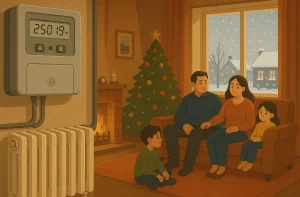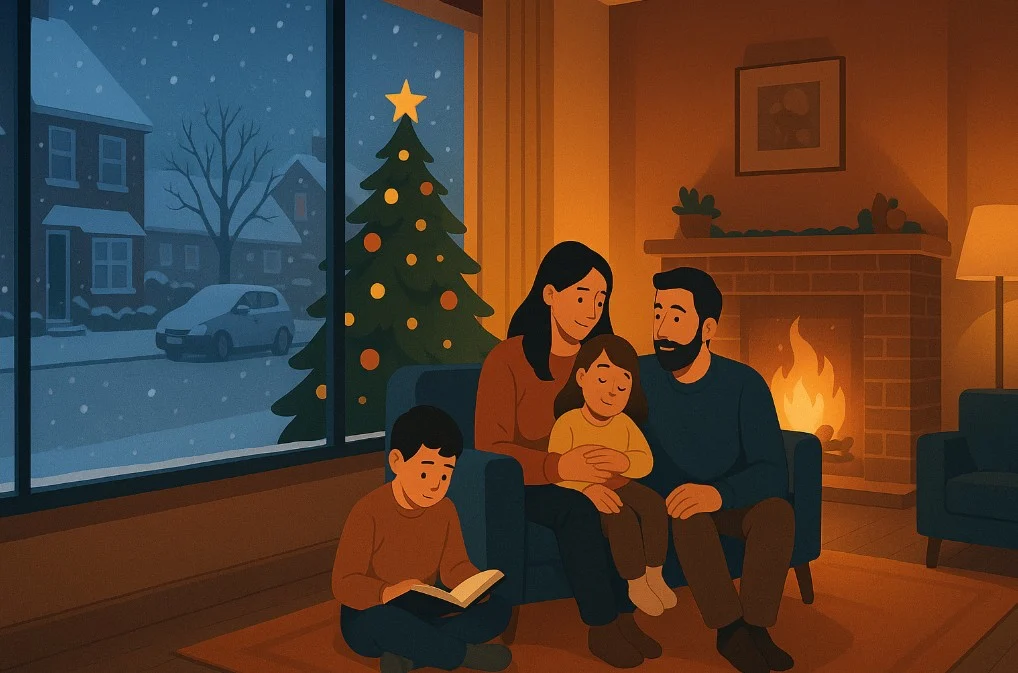Table of Contents
ToggleWill households across the United Kingdom truly receive up to £1085 from the Department for Work and Pensions (DWP) before Christmas? Could this offer genuine relief for families under growing financial pressure, or is it simply speculation? These are the questions on the minds of millions of people as the cost of living continues to rise and seasonal expenses approach.
At present, it is important to clarify that the government has not officially confirmed any new one-off payment of £1085. What is being reported is based on the idea that several existing benefits and schemes, when combined, may add up to more than a thousand pounds for some households. However, confirmation is still pending, and eligibility will depend on individual circumstances.
In contrast, one scheme has been confirmed: the Warm Home Discount, which this year has been expanded to support more than six million households. Alongside this, warnings have been issued by the government about fraud and scams targeting those who receive benefits, as criminals attempt to exploit confusion around financial support.
This article explores what may be possible, what has been confirmed, how scams are targeting benefit claimants, and what households should do to stay safe this winter.
What is the £1085 DWP Payment and is It Confirmed?

The claim that households may receive up to £1085 before Christmas comes from a calculation of overlapping support programmes. For example, a person who receives the Warm Home Discount, Pensioner Winter Fuel Payment, a disability top-up, and a cost of living allowance could see their support total more than £1000 in December.
However, it is vital to stress that no government spokesperson has announced that there will be a £1085 direct payment. Instead, this figure is speculative and represents the potential combined value of multiple schemes. Some households may see that level of support, but most will not. It is more accurate to describe the £1085 figure as an estimate of what is possible, rather than a confirmed government policy.
Who Could Qualify if Support Reaches £1085?
If this figure becomes a reality through combined payments, it is most likely to benefit those already receiving support from multiple schemes. Households on means-tested benefits would be at the core of eligibility, with groups such as:
- Families and individuals on Universal Credit
- Older people claiming Pension Credit and related pensioner benefits
- Disabled people receiving Personal Independence Payment (PIP) or Disability Living Allowance (DLA)
- Households supported by legacy benefits such as Income Support, Income-related Employment and Support Allowance (ESA), or Jobseeker’s Allowance (JSA)
Each household’s circumstances would determine the actual amount. For example, a pensioner with a disability who also receives Pension Credit could qualify for several forms of support, while a single person on Universal Credit may only qualify for one or two.
How Are These Types of DWP Payments Usually Delivered?
When the DWP approves seasonal support, it typically uses existing systems to ensure the money reaches households without delay. Payments are normally made directly into bank accounts, in the same way that regular benefits are paid. Claimants usually do not need to apply for these payments; eligibility is checked automatically through records already held by the DWP.
Letters are also a common part of the process. For example, the Warm Home Discount sends confirmation letters to households between October and December, letting them know that the discount will be applied to their electricity bills. In most cases, the support is either delivered as a direct deposit or, as with the Warm Home Discount, applied automatically to reduce household costs.
What Has Been Confirmed About the Warm Home Discount This Year?

Unlike the speculative £1085 payment, the Warm Home Discount has been officially confirmed for the winter of 2025/26. This scheme provides £150 off electricity bills and is administered through energy suppliers. The funds are not given directly to households but are instead credited to energy accounts, lowering the total amount that needs to be paid.
This year, the scheme has been expanded significantly. An additional 2.7 million households will qualify, bringing the total number of eligible households to more than six million across Great Britain. Those who qualify will receive a letter between mid-October and December, confirming their entitlement.
An extra 2.7 million households are now eligible for the Warm Home Discount this winter.
There is no need to apply for the scheme. If you are sent a text or email about it, it’s a scam.
Thanks @Mattallwright on @BBCTheOneShow for highlighting scam awareness 👇 📹 pic.twitter.com/HNTvm9mMqy
— Department for Energy Security and Net Zero (@energygovuk) September 18, 2025
Eligibility depends on both the household’s income and whether they are receiving certain benefits. In England and Wales, those who are the named bill payer and on benefits such as Housing Benefit, Pension Credit, Universal Credit, Income Support, Income-based JSA, or Income-related ESA will typically qualify. In Scotland, the rules may differ slightly, and households may need to apply directly through their energy supplier.
How Are Scammers Exploiting Benefit Claimants This Winter?
Alongside genuine government support, a rise in fraudulent activity has been recorded. Criminals are taking advantage of the uncertainty surrounding benefit payments to trick people into handing over personal and financial details.
The Department for Energy Security and Net Zero (DESNZ) has specifically warned about scam texts and emails claiming to offer the Warm Home Discount. Fraudsters often tell households that they need to apply for the discount or provide bank details to receive £150. In reality, the Warm Home Discount is applied automatically, and no application is required.
If someone receives a message asking for personal information, it is a scam. The government and Ofgem will never request bank details by text, email, or cold call. Victims of scams risk losing money directly from their accounts, and the financial consequences can be devastating.
How Much Money is Lost to Scams in the UK?
Fraud remains one of the most serious financial threats in the UK. In 2024, scam losses were estimated at £11.4 billion, with the average victim losing around £1,400. However, government statistics suggest that losses can be much higher, with some people losing over £4,600.
DWP-related scams have caused significant harm in the past. In 2019, for example, tens of millions of pounds were stolen through fraudulent Universal Credit claims, with as many as 42,000 people affected. The DWP continues to fight identity theft and fraudulent benefit claims, with billions lost across the welfare system each year.
These figures underline why households need to remain cautious when contacted about financial support.
How Can Households Check if a Payment or Message is Genuine?

The safest approach is to treat any unexpected message with suspicion. For the Warm Home Discount, eligible households will receive a letter by post. If a household believes they qualify but has not received a letter by January, they should contact the Warm Home Discount helpline, which will be open from late October.
The official gov.uk website remains the most reliable source for updates on benefit payments and energy support schemes. Any genuine information will be published there. Households should never provide their bank details in response to unsolicited emails, texts, or calls, and suspicious messages should be reported to Action Fraud.
Could the Warm Home Discount and other benefits really add up to £1085?
It is possible, but it depends entirely on household circumstances. A family or pensioner who qualifies for multiple streams of support could see their total benefits reach or exceed the £1085 figure. The table below demonstrates how different payments might combine.
| Support Type | Amount (£) | Notes |
| Warm Home Discount | 150 | Applied automatically to electricity bills |
| Winter Fuel Payment (Pensioners) | 300+ | For older people to help with heating costs |
| Disability Payment | 150–200 | For people on disability-related benefits |
| Cost of Living Top-Up | 300–400 | For low-income households on Universal Credit etc |
| Potential Total | 1085+ | Only possible if eligible for all listed support |
This example shows that while the £1085 figure is realistic in some cases, it is not universal. Many households will receive less, depending on which benefits they are entitled to.
What Additional Support Are Pensioners Receiving This Year?
Pensioners remain a priority for government support. In addition to the Winter Fuel Payment and the Warm Home Discount, some pensioners can benefit from other forms of help. These include free bus passes, free prescriptions, and free television licences for those over 75 who receive Pension Credit. Collectively, these extras are estimated to be worth around £460 per year.
What Should Households Remember About Winter Support in 2025/26?

The most important point to remember is that the £1085 figure has not been confirmed by the government. It represents a possible combined value of benefits, not an official one-off payment. The confirmed support available is the £150 Warm Home Discount, along with other schemes such as the Winter Fuel Payment and cost of living top-ups.
Households should also remain alert to scams. Fraudsters thrive during periods of uncertainty, and people must avoid clicking on suspicious links or sharing personal information. The government will not ask for bank details by text or email.
Finally, those who believe they qualify for the Warm Home Discount but have not received a letter by January should contact the helpline directly.
Conclusion
As discussions continue, the idea that UK households may receive up to £1085 from the DWP before Christmas remains unconfirmed.
It is possible that some households could see that level of support through a combination of benefits, but no official announcement has been made. What has been confirmed is the expansion of the Warm Home Discount, which will benefit more than six million households by cutting £150 from electricity bills.
At the same time, security warnings underline the importance of vigilance. Scams are widespread, and claimants must stay cautious to avoid losing money. For now, households should rely only on official government information, wait for letters of confirmation, and take comfort in the fact that genuine support is on the way, even if the £1085 payment itself remains uncertain.
FAQs
Will households definitely receive £1085 from the DWP this Christmas?
No. The £1085 figure has not been confirmed by the government. It represents the combined value of different schemes that may apply to some households.
How will I know if I qualify for the Warm Home Discount?
If eligible, you will receive a letter between October and December confirming your £150 discount. The money is not paid directly but applied to your electricity bill.
Do I need to apply for the Warm Home Discount?
No. The scheme is automatic for households in England and Wales. If you receive a message asking you to apply or provide bank details, it is a scam.
Can multiple benefits really add up to more than £1000?
Yes, but only for households that qualify for several forms of support, such as pensioners with disability benefits and cost of living top-ups.
How can I avoid scams linked to benefit payments?
Do not click on links or provide personal details through texts or emails. Always check gov.uk for official updates and report suspicious messages to Action Fraud.
What should I do if I think I am eligible but have not received a Warm Home Discount letter?
Wait until January. If no letter arrives, contact the Warm Home Discount helpline directly for advice.
What additional help can pensioners access this winter?
In addition to heating support, pensioners may qualify for free bus passes, prescriptions, and television licences, particularly if they receive Pension Credit.




